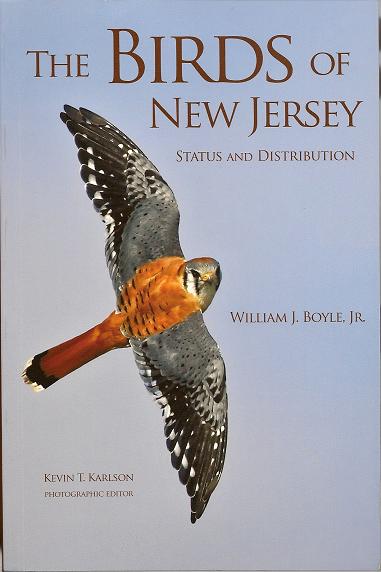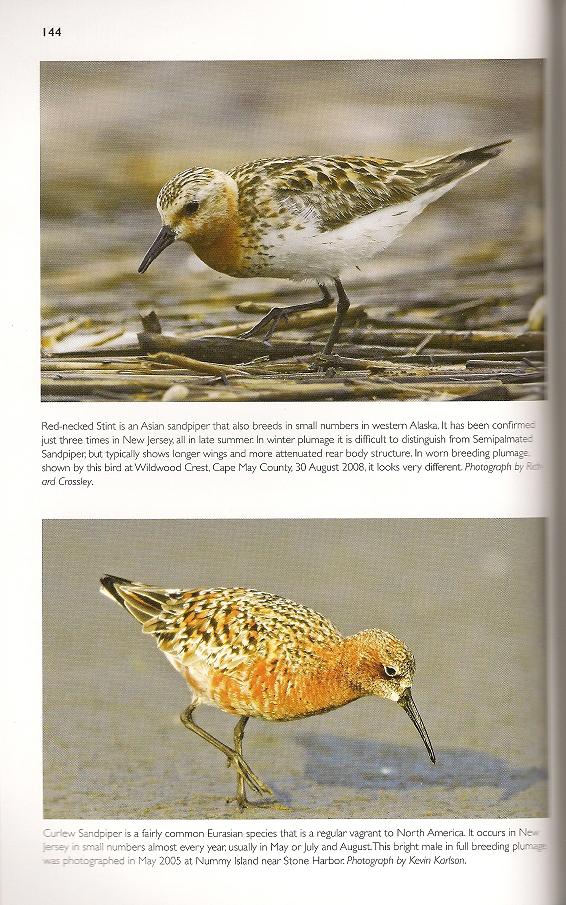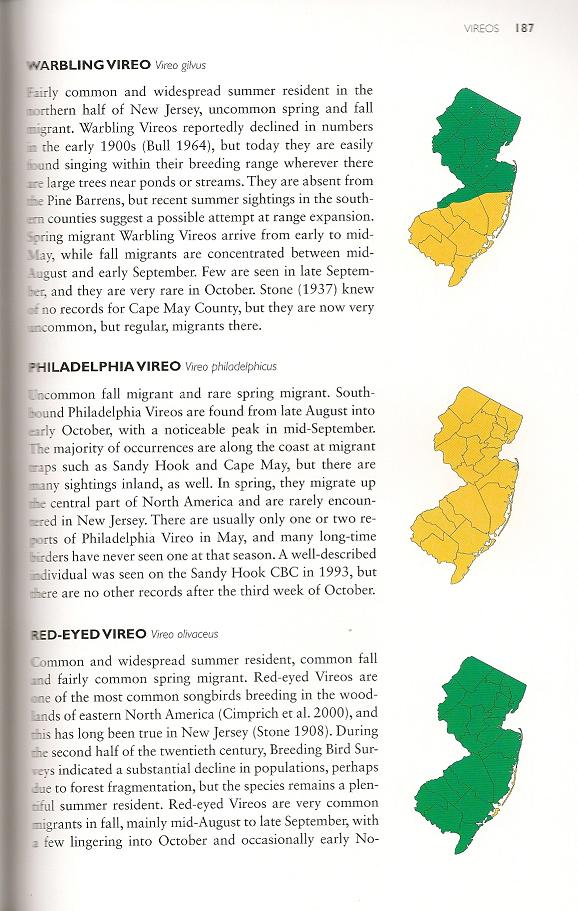Birds of New Jersey, The
Status and Distribution
by Boyle, William J. and Kevin T. Karlson
2011, 308pp, ISBN: 9780691144108
Basics: softcover; reference to the status and distribution to all birds documented from the state; includes 206 good color photos of both common and rare species; 6-color distribution map for the state is shown for each bird; one paragraph of text is dedicated purely to status, abundance, seasonal presence, and historical records
 Birders of New Jersey and the adjacent states will appreciate this good reference on the status and distribution of all the state's birds. Each of the 456 species documented from New Jersey is addressed with its own account. And, 206 species of both common are rare status are shown in good color photographs.
Birders of New Jersey and the adjacent states will appreciate this good reference on the status and distribution of all the state's birds. Each of the 456 species documented from New Jersey is addressed with its own account. And, 206 species of both common are rare status are shown in good color photographs. Nearly all the pictures are of good quality, showing about 45% of the state's total checklist. With one photo per bird, these are not meant for identification but for documentation. This is readily apparent in the photos of vagrants and accidentals to the state where the caption below the photo identifies where and when the bird was photographed. Only a few of the photos for rarer birds are of lower quality; but, that is less important than the documentation they provide for the bird being discovered in the state. Examples include Violet-green Swallow, Large-billed Tern, and Brown Booby.
Nearly all the pictures are of good quality, showing about 45% of the state's total checklist. With one photo per bird, these are not meant for identification but for documentation. This is readily apparent in the photos of vagrants and accidentals to the state where the caption below the photo identifies where and when the bird was photographed. Only a few of the photos for rarer birds are of lower quality; but, that is less important than the documentation they provide for the bird being discovered in the state. Examples include Violet-green Swallow, Large-billed Tern, and Brown Booby.
Yes, better stock photos could have been substituted for those few birds but that would have weakened the value of providing proof of these birds' presence. On the flip side, there are many great photos of rarities such as the Sage Thrasher, Fork-tailed Flycatcher, and Red-necked Stint. Some of the better photos are enlarged to a half-page each and are displayed on 14 pages in the center of the book.
 The account for each bird is composed of a medium to long paragraph that focuses on three things: Status and abundance; distribution; and, dates of seasonal presence or discoveries. For the expected species (e.g., White-breasted Nuthatch, Common Yellowthroat), the seasonal status and abundance are provided for each season. Frequently, brief notes are provided on the habitats in which the birds are expected to be found as well as habitats where they are not. The approximate breeding periods as well as migration arrival and departure dates are outlined. Regarding distribution, the description may be broadly termed as "widespread" or, for birds with a more limited range, may provide specific county or geographic names that define the boundaries of the bird's range.
The account for each bird is composed of a medium to long paragraph that focuses on three things: Status and abundance; distribution; and, dates of seasonal presence or discoveries. For the expected species (e.g., White-breasted Nuthatch, Common Yellowthroat), the seasonal status and abundance are provided for each season. Frequently, brief notes are provided on the habitats in which the birds are expected to be found as well as habitats where they are not. The approximate breeding periods as well as migration arrival and departure dates are outlined. Regarding distribution, the description may be broadly termed as "widespread" or, for birds with a more limited range, may provide specific county or geographic names that define the boundaries of the bird's range. Besides the standard "status and distribution" information, the author has included some interesting and useful information on select species which will be appreciated by the local birders. As an example, Blue Jays are typically regarded as "sedentary", remaining in the state year-round. However, the author points out that small population movements do occur, resulting in as many as a thousand birds being seen on a single day; and, that up to 10% of the population actually moves in and out of the state.
Besides the standard "status and distribution" information, the author has included some interesting and useful information on select species which will be appreciated by the local birders. As an example, Blue Jays are typically regarded as "sedentary", remaining in the state year-round. However, the author points out that small population movements do occur, resulting in as many as a thousand birds being seen on a single day; and, that up to 10% of the population actually moves in and out of the state.
Another interesting local fact is presented with the Carolina and Black-capped Chickadees. The ranges are shown and discussed very nicely. Then, a special point is made to draw attention to an isolated population of the Black-capped at Sandy Hook where the expected Carolina is actually missing.
For the rarer species, specific dates and locations are given for most of the birds. When a bird is rare but still expected during seasonal outbreaks or with increased sightings, the general seasonal timeframe is described along with specific examples of historical records.
 A range map is provided for every bird in the state. The maps, composed of 5 colors representing summer, winter, migration, irregular, and year round, are relatively large (2x1 inches) and show the county borders. Having decent maps is an important component of a records-based reference book such as this. Two other nice aspects about the maps involve the rarer birds. Individual red dots denote specific localities where a vagrant has been documented. And, where the distribution of those rarities is more restricted, such as Cape May, the map zooms in to show only the southern eight counties.
A range map is provided for every bird in the state. The maps, composed of 5 colors representing summer, winter, migration, irregular, and year round, are relatively large (2x1 inches) and show the county borders. Having decent maps is an important component of a records-based reference book such as this. Two other nice aspects about the maps involve the rarer birds. Individual red dots denote specific localities where a vagrant has been documented. And, where the distribution of those rarities is more restricted, such as Cape May, the map zooms in to show only the southern eight counties.
Concluding the book are four appendices that list (a) exotics and birds of uncertain provenance, (b) unaccepted species, (c) list of review species, and, (d) identification information. This last Appendix D (p279) provides some identification material on five pairings of similar species (e.g., Black-chinned Hummingbird, Lesser Nighthawk, or Pacific Golden-Plover). This information compliments the photos shown in the book, providing the reader with some key points for identifying the rarer birds.
Any birder familiar with New Jersey or, who runs out to Cape May eagerly in search of seasonal vagrants or, is geared towards useful ornithological records will appreciate having this book at hand in his library. - (written by Jack, shown with sample pages at Avian Review, May 2011)

No comments:
Post a Comment